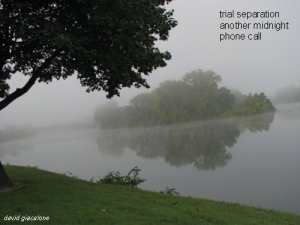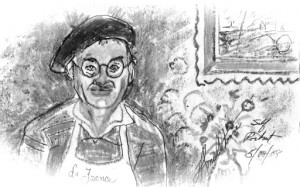— This posting was originally entitled “some Value Billing issues for today’s ABA Ethics Teleconference” —
At noon Eastern Standard Time today, a 90-minute ABA ethics teleconference and audio webcast will take place, titled “Billing Pitfalls & Pratfalls: Avoiding the Ethical Issues that Snag Attorneys.” It’s sponsored by the ABA Family Law Section and Professional Responsibility Center. The description of the session includes this sentence:
 “Our expert faculty will discuss hot topic issues relating to . . . billing based on ‘value pricing’.”
“Our expert faculty will discuss hot topic issues relating to . . . billing based on ‘value pricing’.”
I’m hoping that the faculty, Mark Chinn (of Jackson, MS, Moderator), Lori Nelson (of Salt Lake City, UT ), and Chaim Steinberger (of New York, NY), will spend considerable time on the topic of the fiduciary and ethical obligations of lawyers using value billing — especially on standards for avoiding unreasonably high fees. The issues are most pertinent with regard to the kind of “average” or “Main Street” clients seen by family and divorce lawyers and mediators — clients who are not sophisticated in dealing with lawyers or purchasing legal services.
As used here, “value billing” or “value pricing” is a pricing method in which fees are set in advance of the provision of legal services, based on the client’s perception (guess) of the “value” of those future services, rather than on the lawyer’s time expended, other efforts, costs or risks. [see A. Shields]. Value Billing is distinguished from the more common alternative pricing practice of using a “fixed fee” that attempts to mirror the expected or average cost to the law firm for providing a particular discrete service.
We’ve been raising questions about some of the principles and tactics of value billing for almost five years, and have garnered virtually no analysis of the issues by legal ethics experts or other commentators beyond those with a financial stake in the concept of value billing (a/k/a, value pricing). See, e.g., our posts starting with “Value Billing and Lawyer Ethics” (Jan 28, 2004), and culminating in “broadening the hourly billing debate” (Aug. 18, 2008), through “smart clients care about . . . marketplace ‘value’” (Nov. 25, 2008).
 As discussed in our prior posts, we’ve seen many red flags that call for ethics scrutiny and guidance, or raise fiduciary concerns regarding value billing/pricing. For example, value billing proponents:
As discussed in our prior posts, we’ve seen many red flags that call for ethics scrutiny and guidance, or raise fiduciary concerns regarding value billing/pricing. For example, value billing proponents:
- over and over tell lawyers (and other professionals) they deserve to earn higher fees than they can charge using hourly billing, and that they will indeed achieve such higher fees and greater profits by using value billing; meanwhile, most clients seek alternative pricing mechanisms in search of lower fees than generated under hourly billing.
- argue that value pricing can and should be divorced from the time and effort expended and other costs incurred in providing services to a client; and
- attack hourly billing, the profession’s predominant method for setting fees, and the corresponding, century-old ethical standards for reasonableness (time and effort expended), as themselves unethical — without offering any standard other than the client’s guess as to value prior to seeing the results of the services rendered. Of course, we have fiduciary duties of fair dealing and full disclosure precisely because many clients lack the information to make such judgments about a lawyer’s fees, competence, and diligence. [see our post “chronomentrophobia,” on the ethics and practicalities of hourly billing and alternatives]
- offer tips for reducing a client’s price sensitivity and increasing the lawyer’s leverage in order to charge premium fees, and for achieving higher prices by using information about the client gathered in confidential discussions — including financial status and personal characteristics (such as the client’s emotional condition, anxieties, obsessions, sense of urgency, credulity, etc.).
 advise lawyers to engage in price discrimination among clients who are fully capable of paying fees in full — in order to charge higher fees to those perceived as able or willing to pay more, and therefore to cherry-pick the highest paying clients and prune-away lower-paying ones (rather than serving more buyers, which is the traditional argument justifying price discrimination).
advise lawyers to engage in price discrimination among clients who are fully capable of paying fees in full — in order to charge higher fees to those perceived as able or willing to pay more, and therefore to cherry-pick the highest paying clients and prune-away lower-paying ones (rather than serving more buyers, which is the traditional argument justifying price discrimination).
- boast that value billing allows lawyers to circumvent competitive market forces that prevent an increase in their hourly rate, and to avoid passing on to clients efficiency gains that would reduce the number of hours billed;
- praise “Change Orders” as a way to charge ultra-premium fees for any unexpected or added tasks, by using the leverage over the client that the situation creates [click for our reply to Ron Baker’s Auto Mechanic analogy];
- suggest that lawyers can expect to work fewer hours using value billing and still achieve increased profits.
- use lots of glib mantras, metaphors and maxims — many of which seem specious or inapt.
- suggest that giving a money-back guarantee is sufficient to remove any issue of excessive fees — although Rule 1.5 bans agreeing on an unreasonable fee, as well as collecting one, and clients should not have the burden of deciding when to demand a refund; nor should they pay a hidden premium because the fee comes with a refund guarantee.
Some or all of the above issues need to be discussed today by the panel — and, we hope, someday soon by the law professors at the two major ethics blawgs, The Legal Ethics Forum and The Legal Profession Blog, as well as those at Concurring Opinions, and the consumer advocates at Public Citizen’s CL&P weblog.
As family law and mediation practitioners, I hope the panel will comment on Matt Homann’s approach to value billing for a service such as divorce mediation. Rather than offering a reasonable hourly or flat fee up front, Matt would ask:
“What do you think X would be worth to you?” And remember, “X” is not a contract, will, or deed, but rather peace of mind, security, or some other intangible benefit tied to the specific legal service you’ll be providing.”
[My response to this in a post back in April 2005: “Homann’s Value Billing approach turns the fiduciary relationship into an auction, where the single potential buyer is unaware of the seller’s knockdown price and has no way to judge whether the object for sale is a valuable antique or a fake. No matter the soothing words and good-feely ambiance, it comes down to playing on the consumers fears and sentiments and then saying “make me an offer.” ]
 .. Traditionally, “value” has meant “a good product at a good price,” and has always taken into account competitive market forces that tend to bring price down to the seller’s cost. That’s why computers cost less today than a decade ago, although buyers “need” or “value” them more now, as they have become central in our business and personal lives. So, we need to be suspicious, I believe, of a new definition of value that is based on a buyer guessing in advance just how much a product is worth, without knowing the quality or quantity of the services to be performed or the actual results, and with no connection to what the service costs the seller to produce. To say a fee is “reasonable” if the client agrees to pay it (or agrees to the subjective “value” of the service), makes the rule against unreasonable fees moot. We need a better standard and guidelines when using value billing. Don’t we?
.. Traditionally, “value” has meant “a good product at a good price,” and has always taken into account competitive market forces that tend to bring price down to the seller’s cost. That’s why computers cost less today than a decade ago, although buyers “need” or “value” them more now, as they have become central in our business and personal lives. So, we need to be suspicious, I believe, of a new definition of value that is based on a buyer guessing in advance just how much a product is worth, without knowing the quality or quantity of the services to be performed or the actual results, and with no connection to what the service costs the seller to produce. To say a fee is “reasonable” if the client agrees to pay it (or agrees to the subjective “value” of the service), makes the rule against unreasonable fees moot. We need a better standard and guidelines when using value billing. Don’t we?
update (Dec. 29, 2008): Ron Baker continues his defense of Value Pricing, and I respond, in a set of Comments appearing in a prior post on the topic of value billing.


 “Consumerism, especially the crass king that makes it’s home on Long Island, is an evil. No, not to enjoy material possessions per se, but to need them so desperately to enhance one’s self worth that one would risk the kids’ college or the house to get it.”
“Consumerism, especially the crass king that makes it’s home on Long Island, is an evil. No, not to enjoy material possessions per se, but to need them so desperately to enhance one’s self worth that one would risk the kids’ college or the house to get it.”



 ..
.. 








 p.s. The whole
p.s. The whole 











 Rather than creating a new
Rather than creating a new 

 .. Ms. Beary is also on the minds of many of us in the haijin community this week, because the Revelations: Unedited section of the latest issue of
.. Ms. Beary is also on the minds of many of us in the haijin community this week, because the Revelations: Unedited section of the latest issue of  Serial Presenters: Roberta muses over the soporific benefits of having the same people give virtually the same presentation at more than one conference.
Serial Presenters: Roberta muses over the soporific benefits of having the same people give virtually the same presentation at more than one conference.

 ”At the dawn of the 21st century we also have a collective responsibility to recommit ourselves to the dream; to strengthen that safety net, put the rungs back on that ladder to the middle-class, and give every family the chance that so many of our parents and grandparents had. This responsibility is one that’s been missing from Washington for far too long – a responsibility I intend to take very seriously as president.”
”At the dawn of the 21st century we also have a collective responsibility to recommit ourselves to the dream; to strengthen that safety net, put the rungs back on that ladder to the middle-class, and give every family the chance that so many of our parents and grandparents had. This responsibility is one that’s been missing from Washington for far too long – a responsibility I intend to take very seriously as president.” 


 “It’s one thing to forbid your child to read a book you don’t like or agree with, or to bring it into your home; it’s entirely another to try to impose such a judgment or moral standard on the public — especially in a library, whose function is to make as much information, including opinion, on as many subjects as available as possible.”
“It’s one thing to forbid your child to read a book you don’t like or agree with, or to bring it into your home; it’s entirely another to try to impose such a judgment or moral standard on the public — especially in a library, whose function is to make as much information, including opinion, on as many subjects as available as possible.” “If parents have reservations about the methods advocated by a particular author (in this case, two women doctors with teen children), they should instruct or even order their children to steer clear. But it shouldn’t be their decision to make for the rest of the community.”
“If parents have reservations about the methods advocated by a particular author (in this case, two women doctors with teen children), they should instruct or even order their children to steer clear. But it shouldn’t be their decision to make for the rest of the community.”




 ..
.. 

 The f/k/a Gang keeps harping about the dangers of DWP, and the hypocrisy of politicians who pass laws making hands-free DWP legal. See, the comprehensive post “
The f/k/a Gang keeps harping about the dangers of DWP, and the hypocrisy of politicians who pass laws making hands-free DWP legal. See, the comprehensive post “
 Sexism — real sexism (see
Sexism — real sexism (see 



